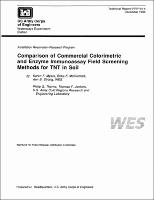Please use this identifier to cite or link to this item:
https://hdl.handle.net/11681/4822| Title: | Comparison of commercial colorimetric and enzyme immunoassay field screening methods for TNT in soil |
| Authors: | Cold Regions Research and Engineering Laboratory (U.S.) Installation Restoration Research Program (U.S.) Myers, Karen F. McCormick, Erika F. Strong, Ann B. Thorne, Philip G. Jenkins, Thomas F. |
| Keywords: | Enzyme Immunoassay Field screening TNT Colorimetric analysis Soils testing Enzyme-linked immunosorbent assay |
| Publisher: | Environmental Laboratory (U.S.) Engineer Research and Development Center (U.S.) |
| Description: | Technical Report Abstract: A study comparing two commercially available methods of field screening for TNT in soil, utilized 99 soil samples from the Naval Surface Warfare Center, Crane, Indiana. All soil samples were analyzed using a commercial calorimetric method (EnSys) and a commercial enzyme immunoassaymethod (D TECH), and the results were compared with those from the standard reversed-phase high performance-liquid chromatography(RP-HPLC) laboratory method (SW846 Method 8330). Comparisons were made relative to numerical agreement of screening results with laboratory analysis by RP-HPLC and usage in two distinct scenarios. Of the 99 soil samples analyzed by the laboratory method, 25 had TNT (2,4,6-trinitrotoluene) concentrations greater than the RP-HPLC detection limit of 0.3 μg/g. Of these 25, 11 had concentrations in the range 0.3-1.0 μg/g and 14 had concentrations greater than 1.0 μg/g (the operating field screening detection limit for this study). Results were positive from both field screening methods for all 14 soils with TNT concentrations greater than 1.0 μg/g by RP-HPLC. Thus, no false negatives were observed by either method for samples above the field screening detection limit. Of the 11 samples with TNT concentrations in the range 0.3- 1.0 μg/g, D TECH failed to detect 3 samples and EnSys failed to detect 2 samples. For 66 of the samples, RP-HPLC analysis yielded nondetects for TNT and other nitroaromatics. For these samples, the D TECH kit yielded 63 nondetects and 3 false positives, and the EnSys method resulted in 64 nondetects and 2 false positives. Quantitative results from both field methods were regressed against the numerical results of the RP-HPLC analyses. Somewhat better agreement was obtained between results from RP-HPLC with the results from the EnSys method. These better results appa to be largely due to a decrease in sampling error achieved by air drying a fairly large portion of soil and homogenizing prior to subsampling. Results suggest that both kits respond to the presence of other nitroaromatics in addition to TNT. For the EnSys kit, different colored solutions are produced when the major nitroaromatic present is TNT (pink-red) or 2,4-DNT (blue-purple). The authors suggest that the D TECH kit is best suited to use in a pure field screening mode, where quantitative results are taken from laboratory analyses. Quantitative results from the EnSys kit appear to be of sufficient quality to permit rapid decisions in the field as to whether TNT concentrations are above or below an action concentration. When used according to manufacturer’s directions, the D TECH kit produces results much more rapidly, since the EnSys kit requires that soils be dried prior to use. |
| Rights: | Approved for public release; distribution is unlimited. |
| URI: | http://hdl.handle.net/11681/4822 |
| Appears in Collections: | Technical Report |
Files in This Item:
| File | Description | Size | Format | |
|---|---|---|---|---|
| IRRP-TR-94-4.pdf | 2.88 MB | Adobe PDF |  View/Open |